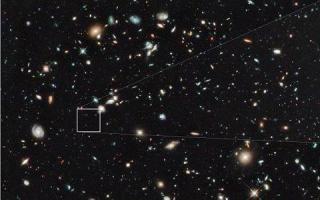
The farthest and one of the very earliest galaxies ever seen in the universe appears as a faint red blob in this ultra-deep�field exposure taken with NASA's Hubble Space Telescope. Photo: NASA, ESA, G. Illingworth (University of California, Santa Cruz), R. Bouwens (University of California, Santa Cruz and Leiden University), and the HUDF09 Team.
WASHINGTON (BNS): An international team of astronomers claim to have discovered what they believe is the most distant and ancient galaxy ever found.
The light of the galaxy discovered by NASA's Hubble Space Telescope has travelled for 13.2 billion years to reach Hubble, which corresponds to a redshift around 10.
The tiny, dim object is a compact galaxy of blue stars that existed 480 million years after the big bang. More than 100 such mini-galaxies would be needed to make up our Milky Way. The new research offers surprising evidence that the rate of star birth in the early universe grew dramatically, increasing by about a factor of 10 from 480 million years to 650 million years after the big bang, according to a news report by NASA.
"NASA continues to reach for new heights, and this latest Hubble discovery will deepen our understanding of the universe and benefit generations to come," NASA Administrator Charles Bolden, who was the pilot of the space shuttle mission that carried Hubble to orbit, was quoted as saying in the report.
The observation was made with the Wide Field Camera 3 starting just a few months after it was installed in the observatory in May 2009, during the last NASA space shuttle servicing mission to Hubble. After more than a year of detailed observations and analysis, the object was positively identified in the camera's Hubble Ultra Deep Field-Infrared data taken in the late summers of 2009 and 2010.
"These observations provide us with our best insights yet into the likely nature of the earlier generation of primeval objects that we are yet to find," added Rychard Bouwens of Leiden University in the Netherlands.
The object appears as a faint dot of starlight in the Hubble exposures, and although its individual stars can't be resolved by Hubble, the evidence suggests that this is a compact galaxy of hot stars that first started to form over 100-200 million years earlier, from gas trapped in a pocket of dark matter.
The findings are published in the January 27 issue of the journal Nature.
 Previous Article
Previous Article













The Indian Air Force, in its flight trials evaluation report submitted before the Defence Ministry l..
view articleAn insight into the Medium Multi-Role Combat Aircraft competition...
view articleSky enthusiasts can now spot the International Space Station (ISS) commanded by Indian-American astr..
view article